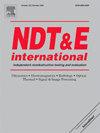Fatigue life prediction for CFRP laminates using multi-mode Lamb wave velocity and Bayesian model selection
IF 4.1
2区 材料科学
Q1 MATERIALS SCIENCE, CHARACTERIZATION & TESTING
引用次数: 0
Abstract
This paper proposed a new approach for fatigue life prediction of carbon fiber reinforced polymer (CFRP) laminates using Bayesian model selection and multi-mode Lamb wave velocity. It is aimed to overcome the difficulties of large dispersity observed when testing of the material, caused by both complex damage mechanisms and fluctuation of data measurement due to the high damping property of CFRP. Specifically, both S0 and A0 mode Lamb wave velocities were recorded during a controlled tensile fatigue experiment under various load severities. Considering the possible underlying damage mechanisms, two stiffness degradation models are employed to describe the evolution trend of the collected velocity data of the two modes, respectively, forming effectively four sub models. Then Bayesian evidence is calculated by nested sampling (NS) algorithm to evaluate the strength of each sub model, the sub model with the strongest evidence is selected, the significance of which against other unselected sub models is also evaluated by Jeffrey's scale. Based on this, the fatigue life is predicted using the selected sub model, which shows good accuracy and consistency, and the effectiveness of model selection with multi-mode Lamb wave velocity is validated through a comparison between the results. Finally, a ‘most conservative’ strategy is also tested and compared for the safety requirement in practical application.
求助全文
约1分钟内获得全文
求助全文
来源期刊

Ndt & E International
工程技术-材料科学:表征与测试
CiteScore
7.20
自引率
9.50%
发文量
121
审稿时长
55 days
期刊介绍:
NDT&E international publishes peer-reviewed results of original research and development in all categories of the fields of nondestructive testing and evaluation including ultrasonics, electromagnetics, radiography, optical and thermal methods. In addition to traditional NDE topics, the emerging technology area of inspection of civil structures and materials is also emphasized. The journal publishes original papers on research and development of new inspection techniques and methods, as well as on novel and innovative applications of established methods. Papers on NDE sensors and their applications both for inspection and process control, as well as papers describing novel NDE systems for structural health monitoring and their performance in industrial settings are also considered. Other regular features include international news, new equipment and a calendar of forthcoming worldwide meetings. This journal is listed in Current Contents.
 求助内容:
求助内容: 应助结果提醒方式:
应助结果提醒方式:


